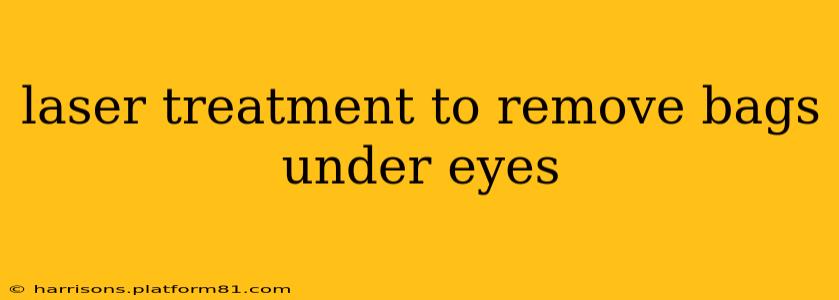Under-eye bags can be a frustrating cosmetic concern, making you look older and more tired than you feel. While makeup can temporarily mask the problem, many seek more permanent solutions. Laser treatment has emerged as a popular option, offering a potentially effective way to reduce or eliminate under-eye bags. This comprehensive guide will explore laser treatment for under-eye bags, addressing common questions and concerns.
What Causes Under-Eye Bags?
Before diving into treatment options, understanding the root causes of under-eye bags is crucial. Several factors contribute to their development, including:
- Genetics: A family history of under-eye bags significantly increases your likelihood of developing them. This is often due to inherited structural features of the eye area.
- Aging: As we age, the skin loses elasticity and collagen, leading to sagging and the formation of under-eye bags. The fat pads supporting the eyes can also weaken and protrude.
- Fluid Retention: Fluid buildup under the eyes can cause puffiness and worsen the appearance of bags. This can be exacerbated by poor sleep, allergies, or high salt intake.
- Sun Exposure: Years of sun exposure can damage the skin's collagen and elastin, contributing to premature aging and the formation of under-eye bags.
- Lack of Sleep: Insufficient sleep can lead to fluid retention, making under-eye bags more prominent.
Understanding these causes helps in determining the best approach to treatment, including whether laser treatment is the right choice for you.
What Types of Laser Treatments Are Used for Under-Eye Bags?
Several laser technologies can be used to address under-eye bags, each with its own mechanism of action and benefits:
- Carbon Dioxide (CO2) Laser Resurfacing: This ablative laser removes the outer layers of skin, stimulating collagen production and tightening the skin. While effective, it has a longer recovery time and carries a higher risk of complications. It’s less commonly used for under-eye bags due to the delicate nature of the skin in this area.
- Fractional CO2 Laser Resurfacing: This is a less aggressive version of CO2 laser resurfacing, treating only small fractions of the skin. This minimizes downtime and the risk of complications while still stimulating collagen production.
- Erbium:YAG Laser Resurfacing: Similar to CO2 laser, but generally considered less aggressive and with faster healing. This is also often used in conjunction with other treatments to address under-eye bags.
- Non-ablative Lasers: These lasers work by heating the deeper layers of the skin without removing any tissue. They stimulate collagen production and improve skin texture, but the effects may be less dramatic than ablative lasers. These are often preferred for the sensitive under-eye area.
The choice of laser treatment will depend on several factors, including the severity of your under-eye bags, your skin type, and your desired outcome. A consultation with a qualified dermatologist or plastic surgeon is essential to determine the most appropriate approach.
How Long Does it Take to See Results from Laser Treatment for Under-Eye Bags?
The results of laser treatment for under-eye bags are not immediate. It usually takes several weeks to months to see noticeable improvements. Collagen production, which is stimulated by the laser, is a gradual process. Multiple treatment sessions may be necessary to achieve optimal results. Your doctor will provide a realistic timeframe based on your individual case.
What Is the Recovery Time After Laser Treatment for Under-Eye Bags?
Recovery time varies depending on the type of laser used. Non-ablative lasers typically involve minimal downtime, with some redness and swelling subsiding within a few days. Ablative lasers, on the other hand, can lead to significant swelling, redness, and crusting, requiring several weeks of recovery. Your doctor will provide detailed instructions on post-treatment care.
Are There Any Side Effects of Laser Treatment for Under-Eye Bags?
As with any medical procedure, there are potential side effects associated with laser treatment for under-eye bags. These may include:
- Redness and Swelling: This is common and usually subsides within a few days or weeks.
- Bruising: Bruising can occur, especially with more aggressive treatments.
- Infection: Infection is a rare but possible complication.
- Hypopigmentation or Hyperpigmentation: Changes in skin color are possible, although usually temporary.
- Scarring: Scarring is uncommon but can occur, especially with ablative lasers.
Your doctor will discuss these potential risks and complications with you before the procedure.
What is the Cost of Laser Treatment for Under-Eye Bags?
The cost of laser treatment for under-eye bags varies significantly depending on several factors, including the type of laser used, the number of treatment sessions required, and the geographical location. It is best to consult with a dermatologist or plastic surgeon to get an accurate cost estimate.
Is Laser Treatment for Under Eye Bags Right for Me?
Laser treatment is not a suitable solution for everyone. A thorough consultation with a qualified medical professional is crucial to determine if it's the right option for you. They will assess your skin type, the severity of your under-eye bags, and your overall health to determine the most appropriate treatment plan. They will also discuss the potential risks and benefits, ensuring you make an informed decision.
This comprehensive guide provides valuable information on laser treatment for under-eye bags. Remember, this information is for educational purposes only and should not be considered medical advice. Always consult with a qualified dermatologist or plastic surgeon before undergoing any cosmetic procedure.
